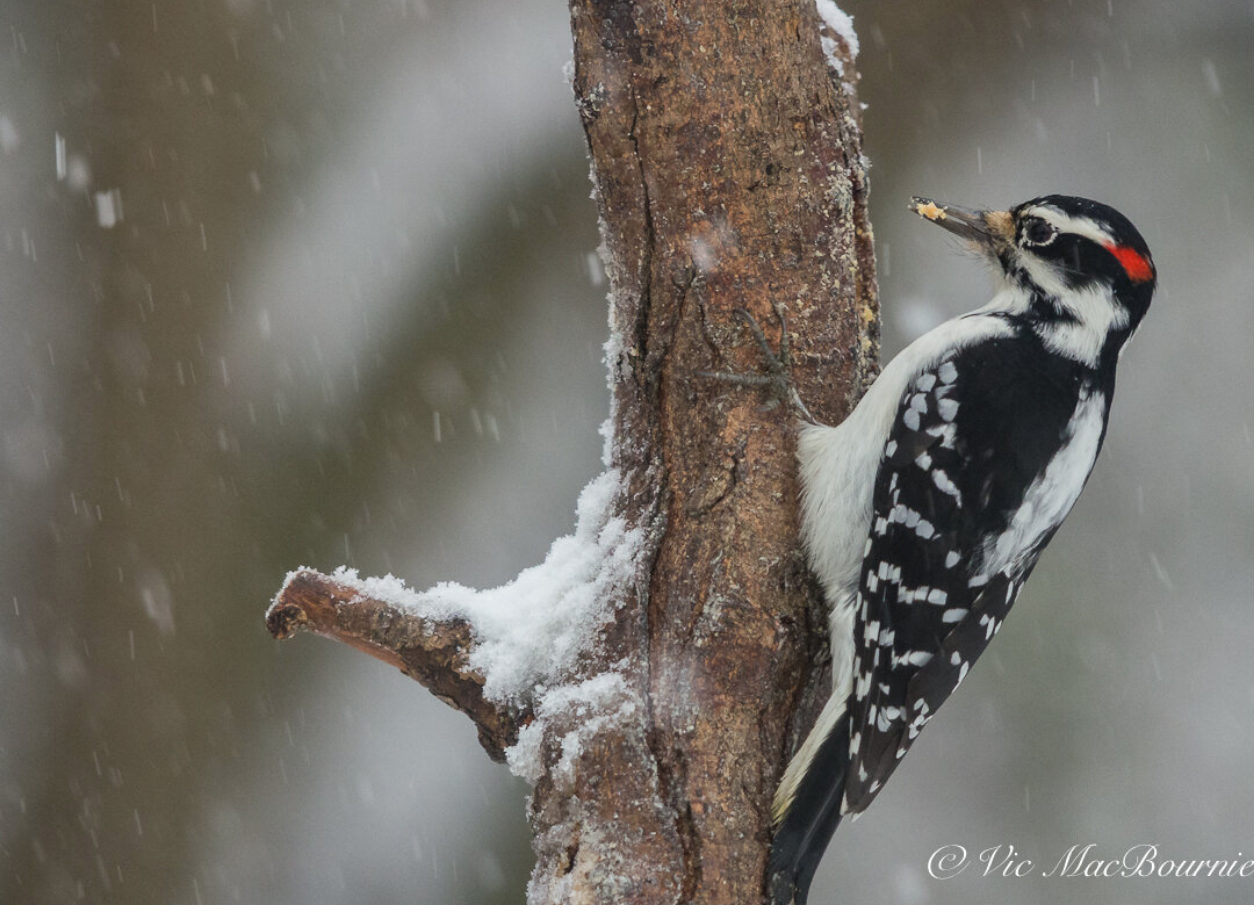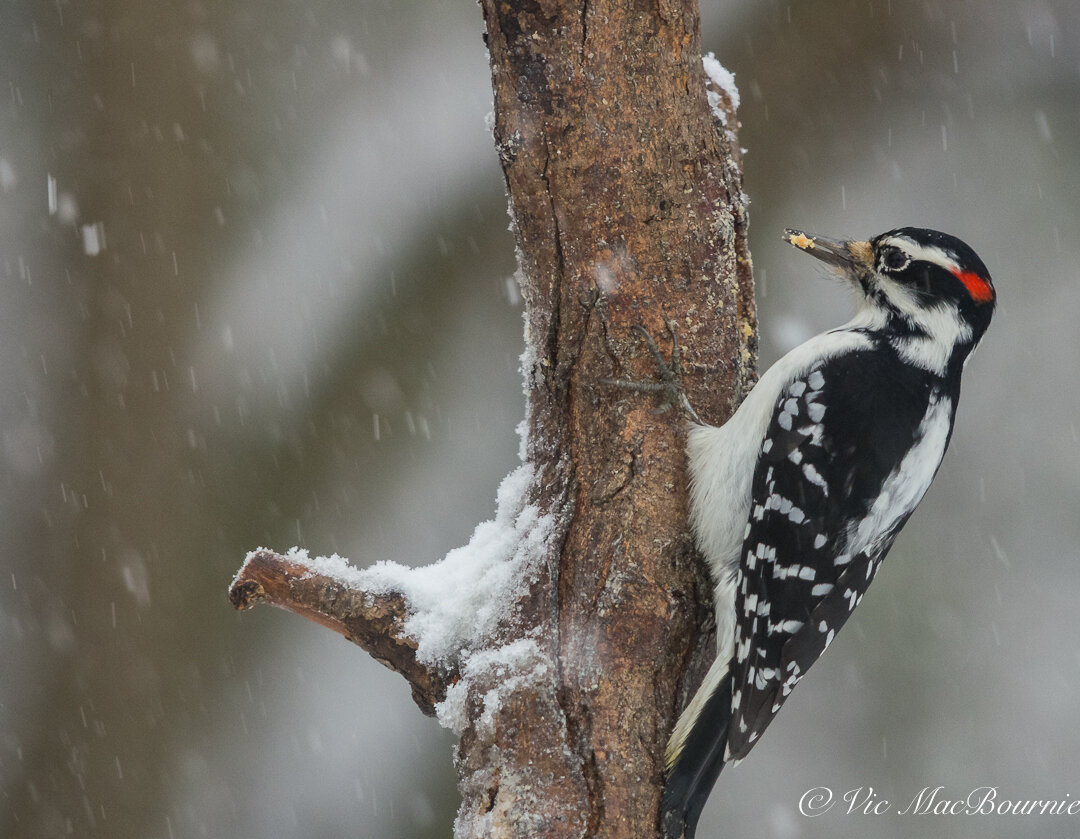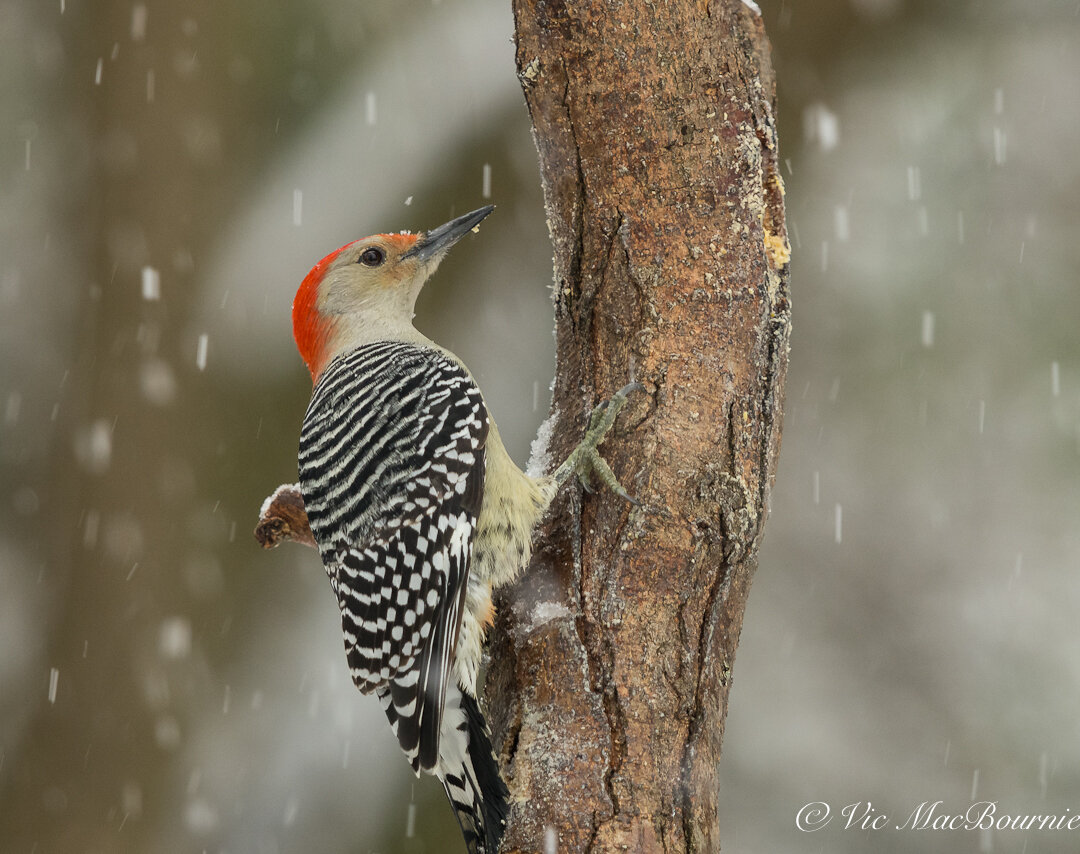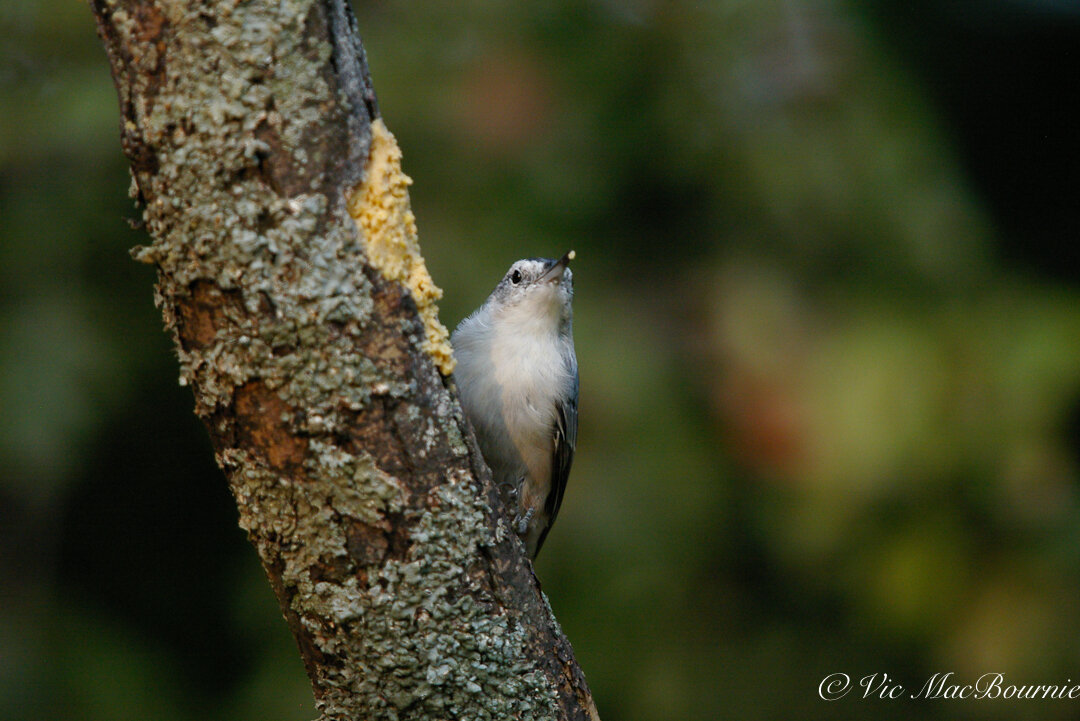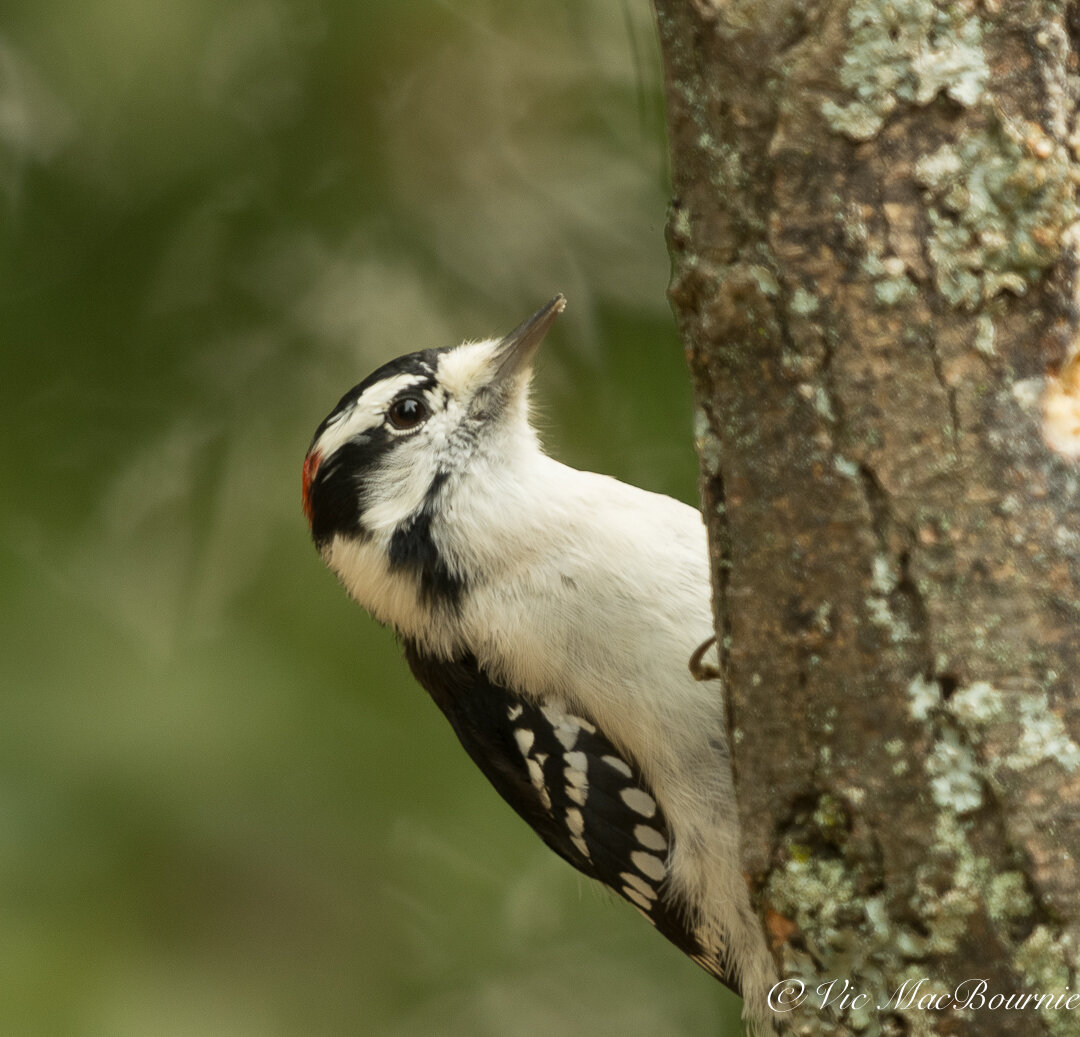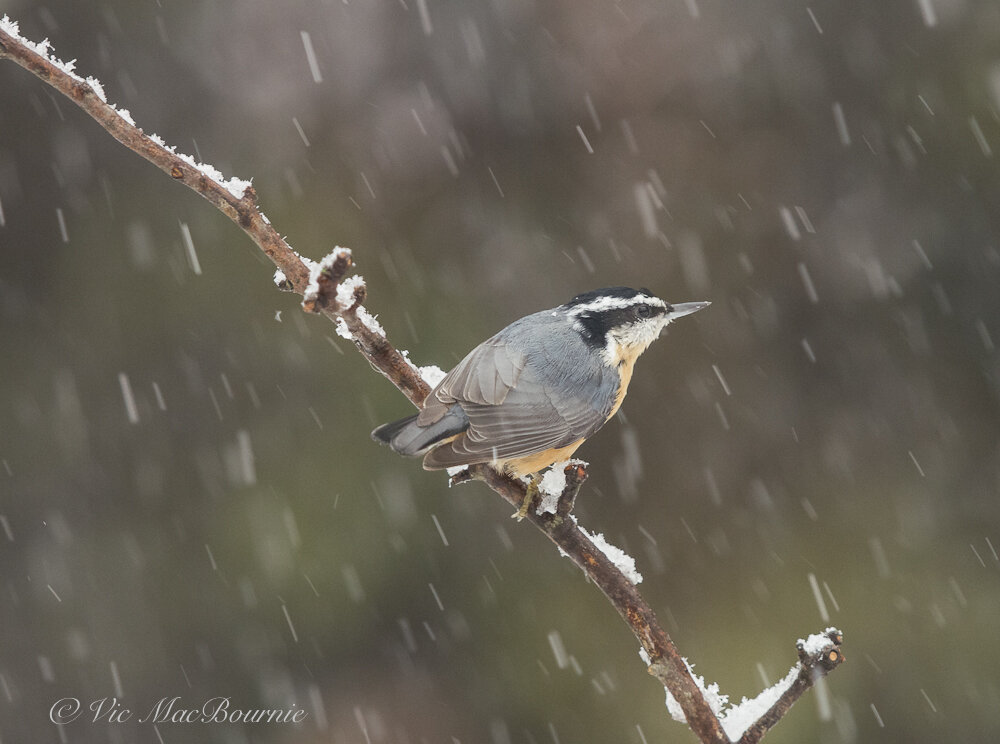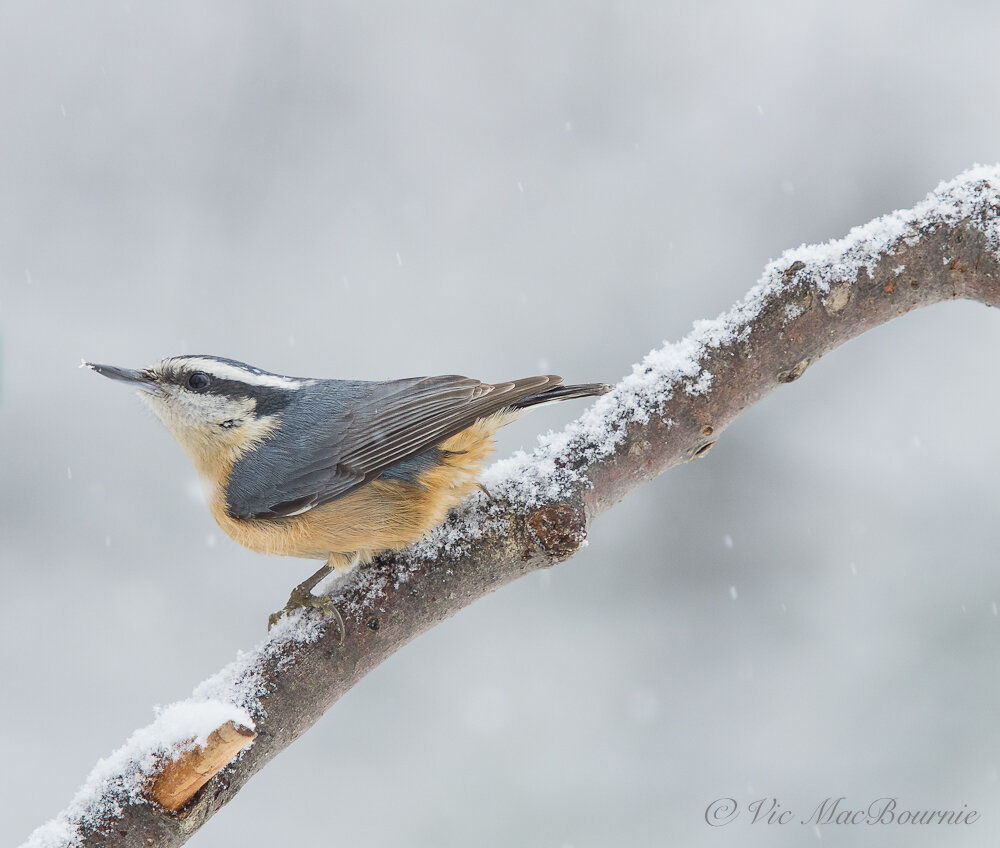Bark butter and DIY bird feeders
The combination of a DIY feeder and WBU’s Bark Butter is an irresistible draw for more than 150 species of birds. If attracting woodpeckers, nuthatches and chickadees along with warblers sounds good, check out this simple and easy to make feeder and food combination.
Natural feeder is irresistible to 152 species of birds
Combining Bark Butter with a DIY bird feeder has become my favourite combination for attracting woodpeckers, nuthatches and chickadees to my wildlife, woodland garden.
It has also quickly become my favourite feeder combo to photograph birds in a natural setting.
So if you are like me and love either photographing backyard birds, or simply watching woodpeckers, nuthatches and other suet-loving garden visitors as they peck away gathering food for the winter, then you will love the simplicity of creating this DIY branch feeder. The feeders are so easy to make and appreciated by out feathered friends that I’ve already made two and plan on making many more in the near future.
But before digging in on how to make the DIY feeder let’s talk a little about Wild Birds Unlimited Bark Butter.
There are other spreadable-suet products available that might suit your needs. I just can’t speak to them. I do plan to order some of these products from Amazon and will report back.
A woodpecker removes a piece of Bark Butter from the DIY branch feeder.
What’s Bark Butter?
Bark Butter is a spreadable suet-peanut butter and corn blend that can be easily spread on a rough surface like tree bark or stuffed into holes or small crevices that are easily accessible to many birds. It is especially accessible to those birds with long beaks that can reach into cracks and areas where squirrels may have difficulty reaching. It is sold, in many different forms, through Wild Birds Unlimited stores and on line throughout Canada and the United States. The formula for Jim’s Birdacious Bark Butter is said to be created by Jim Carpenter, founder of Wild Birds Unlimited. It is advertised as a food source that attracts a greater variety of birds than any other food source including regular suet.
This Flicker is working one of the many Bark Butter pockets in the DIY branch feeder.
I can’t verify the claims that it attracts more than 152 species of birds, but I can verify that this stuff is a joy to use. Its peanut butter base makes handling it enjoyable. In fact, I mostly just scoop it out of its plastic container using my hands and stuff it into the holes I’ve drilled into the DIY feeder tree branch. Any access bark butter that gets on my hand is simply rubbed into the crevices of the branch’s bark.
Getting back to those 152 different species that Bark Butter is said to attract. I have no doubts that the claims are true that Bark Butter attracts everything from woodpeckers like Flickers, Downies, Hairy and red-breasted woodpeckers, to Brown Creepers, Chickadees, Jays and even warblers. As many know, attracting warblers to our gardens is not always easy. Anything that brings warblers into the yard is a good thing and, since Warblers are big insect eaters, the bark bits with insects would be a good choice to attract them.
Bark Butter is not inexpensive so care should be taken to use it wisely and do everything possible to keep squirrels and other mammals from feasting on it.
Although it is recommended to be spread on tree bark, if squirrels discover it before the birds, there’s a good chance they’ll devour most of it before the birds get to it.
The DIY feeder helps solve this problem. Because it can be hung from a feeding station complete with squirrel baffles and placed is an area of your garden that makes access difficult for raccoons, squirrels and other garden critters, it’s easy to maximize the benefits of the butter.
As an experiment, I have created two of these feeders. One is hanging off the feeding station and therefore protected from squirrels. The other feeder is part of a large tree branch that has been dug into the ground and allows easy access to red and grey squirrels among other backyard wildlife critters who discover it.
A Nuthatch feasts on Bark Butter at the lichen-covered DIY branch feeder.
As a result of the experiment, I can attest to squirrels’ love of Bark Butter and the importance of making access difficult for them. Once loaded up, the Bark Butter feeder on the feeding station remains available to the birds for several days, while the branch feeder is more or less devoured in a day or two. I suppose using the hot pepper mix is appropriate in this circumstance to keep squirrels away, but after my fair share of hot wings, I’m not a fan of teaching the squirrels a hard-earned lesson.
In the end, I like both feeders. If saving money is important to you, however, it’s probably wise to make it difficult for squirrels to get access to your DIY feeders.
The bark butter is available in plastic tubs in both regular and a hot pepper blend that helps detract squirrels from feasting on the rather expensive feed. It’s also available in a Bugs and Bits blend, which incorporates small pellets of bark butter together with insect parts including meal worms. The same pellet-shaped Bark Butter Bits are available without the insects and with hot pepper. There is also Bark Butter quickbites and a large no-melt suet cyclinder. Both are available in regular and hot pepper.
Be aware that some Wild Birds Unlimited locations choose not to sell the hot pepper Bark Butter.
For more on Building your Garden on a Budget go here.
While I get great enjoyment from my bird feeding stations, providing natural food sources to our feathered friends is always the goal we should aspire to in our gardens. I have written a comprehensive post on feeding birds naturally. You can read about it here.
Simple, easy-to-create DIY feeders
There are many different ways to use Bark Butter. One of the simplest ways is to gather pine cones from the garden and smother them with the bark butter. These can be hung from tree branches throughout the garden especially during or just before a snowfall.
But my favourite method is to use a one- or two-foot branch cut from or left over from a tree pruning, either from your own tree or a neighbours’. My feeders are a little thicker than a man’s wrist, but larger, heavier branches can be used for larger woodpeckers like the Pileated woodpecker.
These feeders are so simple to make that the process is almost not worth describing. But here is a simple description of the process.
• Drill a hole through the branch maybe an inch or two down from an end to insert string or preferably wire, which will be used to hang the feeder.
• Then, using a larger drill bit, start drilling several pockets or holes in the branch at regular intervals.
• If there is a side branch, leave some of it to act as a small perch for the birds. Then drill a hole above the perch to act as a convenient location for birds to get easy access to the Bark Butter.
• I use a combination of drilled pockets that go half way into the branch, full holes drilled right through the branch to provide birds with different length beaks access to the butter.
• Once the wire is attached and the Bark Butter applied, you can hang the feeder. Leave room around the feeder to give visitors access from all sides.
• Refilling the tree branch with suet is just a matter of taking a clump of the Bark Butter and stuffing it into the holes. I do it with my hands but you could use an old spoon. Wild Birds Unlimited says to use a fork for the final application because the rungs leave a criss-cross pattern in the butter that birds can easily pick off and eat.
Create a free-standing feeder for all garden visitors
• Our other Bark Butter feeder is nothing but a larger 8- to 9-foot branch partially buried into the ground a couple of feet.
• Once stabilized in the ground, drill several holes and pockets in the branch at various heights to provide birds with several feeding areas up and down the branch.
• Smaller holes can be drilled into the branch to insert perches for birds or long screws to hang smaller feeders from. This is an ideal spot to add Bark Butter-infused pine cones.
• I like to fill this bird feeder an hour or two before going out to photograph the birds to give me another potential photo location.
Branch feeders are ideal photographic stages
This larger branch has become a favourite location for birds and squirrels who enjoy taking up a position on top to scan the garden. It has only been up for about eight months and I’m sill waiting for a large hawk or owl to discover it and use it as a hunting perch.
But I’m confident that time will come and I hope to be there in my Tragopan V6 photo blind ready to capture the image.
In the meantime, I’ll enjoy the large variety of backyard birds providing me with endless photographic opportunities on my two natural feeders.
The lure of the DIY branch feeder and Bark Butter is irresistible to so many birds. This makes it ideal for photographers to capture natural images (much like the ones featured in this article) of the many varieties that visit. The DIY feeder combined with a photographic blind like the Tragopan V6 one-person blind, makes it easy to get up close to some of your favourite species. The feeders and the blind are also portable enough to move them around the garden to obtain the background of your choosing.
If photographing birds is one of your primary goals behind creating the branch feeders, be careful to drill your holes strategically to hide as many as possible from the camera lens. By keeping the suet pockets on one side and shooting from an angle that keeps the suet more or less hidden, the resulting photos can look very natural.
I like to look for branches from older trees that already have lichen and moss growing on them. A chainsaw makes creating several lengths of feeders easy and quick work.
Gardening on a budget links
Ten money-saving tips for the weekend gardener
DIY Bark Butter feeder for Woodpeckers
DIY reflection pond for photography
Click & Grow is ideal for Native Plants from seed
Garden photography: Tips to photographing hummingbirds in flight
Backyard bird photography involves planning, patience and the right equipment. Months of planning, hours of waiting and about five seconds of shooting resulted in this photograph of the hummingbird at a native cardinal flower.
Planning, patience: Key to capturing garden bird photographs
Garden photography isn’t always easy. In fact, I figure the photo took about six hours of patience and five seconds of shooting.
The result, pretty close to what I hoped for photographing with natural light in the shade of a magnolia tree. An electronic flash would certainly have punched it up both in colour and sharpness, but I decided to go with natural light.
The flash photo can wait for now.
Was luck involved? There is always a certain amount of luck in any good image, but to me luck would have meant getting the photograph in the first half hour, not the sixth.
Photographers looking to do more backyard bird photography might find it helpful to delve a little deeper into the creation of this image.
If I could have only one lens for wildlife and birds in the garden, it would be my F* 300mm F4.5. Check out my full story on the lens by clicking the link.
Much like most bird photography, good planning, lots of patience, and the right equipment went a long way in capturing the image.
Hummingbird feeds from a cardinal flower in the garden.
Planning: The planning started when I ordered the native plant from Onplants.ca back in the spring. I knew hummingbirds loved Cardinal flowers so I ordered three and planted them in an area where they would prosper. Then, I planted it where I would have easy access to them for photography. Beside the patio and a couple of feet from where I normally sit is the ideal location. And, so, that’s where the plants found a home. Nearby, there are three hummingbird feeders that encourage the birds to the general vicinity to where the plant is located.
Patience: Six hours speaks to the patience it took to get the shot. That length of time can be extremely long if you are out in the field, but sitting in a comfortable chair in the backyard makes the wait much easier. It’s one of the big benefits of practising backyard bird photography. Have a coffee, a beer or maybe a glass of wine and take your best shots. Couldn’t be easier.
In most cases a photography blind is not needed when shooting hummingbirds providing you take the time to acclimatize the birds to your presence.
(If you are interested in exploring garden photography at a higher level, be sure to check out my comprehensive post on the Best camera and lens for Garden Photography.)
Looking to upgrade your camera or lenses? Check out the excellent used cameras and lenses at KEH Camera Exchange.
Even if you’re not taking pictures, sitting out in the same chair and moving slowly will eventually cause the birds to recognize you as nonthreatening and allow them to go about their day as if you are not really even there.
This will not work with all birds, but many, especially Hummingbirds will eventually simply ignore you if you are always around their feeders.
Equipment: Bird photography has always been a specialty field involving high-powered cameras, motordrives and long, fast, expensive lenses. A visit to Point Pelee during spring migration, or any other of the birding hot spots around the globe, will certainly convince you that admission into serious bird photography requires more than an iphone or a point-and-shoot camera.
That’s not to say that with very careful planning you can’t get some good shots with these cameras. It’s just that it would be hard to do it consistently and the effort put forward might not be worth the results.
The small size of the hummingbird makes it even more difficult to get good results with these cameras.
So, with that in mind, I took the hummingbird challenge armed with a 35mm SLR camera with built-in motordrive and a 300mm F4.5 close-focusing telephoto lens (with a focal lens of around 450mm on the cropped sensor).
If I could have only one lens for wildlife and birds in the garden, it would be my F* 300mm F4.5. Check out my full story on the lens by clicking the link.
But this was not really the secret behind getting the photograph. They are merely the tools that helped make it possible.
The secret was a tripod, an electronic shutter release, and a camera set on backfocus.
With the camera locked into place on the tripod, and the electronic release ready to trip the shutter without moving the camera, the plan was almost complete.
If you are considering a new camera or lens to capture your best garden photography, travel photography or maybe just your kids and grandchildren, consider checking out the exceptional used camera equipment at KEH Camera Exchange. It’s a U.S. based camera and lens reseller. click on this link to check out their daily offerings.
However, one big problem remained. Normally, when you press the shutter halfway down, the camera refocuses, often going into search mode to find something to focus on. Trying to focus blindly with the hummingbird moving about makes it close to impossible.
That’s where back focus came into play.
What’s back focus you may ask?
On the back of most higher-quality 35mm SLRs is a button that enables the photographer to focus separately from the shutter control button. By using the back focus button, I was able to prefocus on the flowers and then release the shutter without it refocusing when the hummingbird reached the area where I expected it would be in-focus.
Focusing on the flower and then putting the camera into manual focus mode would also have worked.
In the end, the combination of planning, patience and equipment came together to create a pleasing shot. Months in the planning, hours of waiting for the plan to come together and a few seconds of actual shooting made it all happen.
A lucky shot if I ever saw one.
A female ruby-throated hummingbird feeds from a cardinal flower on a sunny afternoon.
Later in the season, I set up a similar situation where the Cardinal flower was primarily in the sun.
The higher shutter speed that the additional light provided helped to get the frenetic little bird in focus and brightened the colours in its feathers. I’m not sure I like the photos any more than the earlier images taken in a shadier part of the garden, but taking it was certainly a simpler process.
Again, patience was the key. The process was similar. Camera on a tripod focused on the flower (again using the back focus button) and a remote release attached to the camera. Every time the hummingbird came to feed, I took several photographs hoping that enough of them would be in focus and sharp.
As I said earlier, photographing the bird in a sunny location brought out the colours, provided a highlight in the bird’s eye and allowed me to shoot at a higher f-stop which helped to capture more of the bird in focus.
This page contains affiliate links. If you purchase a product through one of them, I will receive a commission (at no additional cost to you) I try to only endorse products I have either used, have complete confidence in, or have experience with the manufacturer. Thank you for your support. This blog would not be possible without your continued support.
How to attract nuthatches to your woodland garden
How can you not love our Nuthatches? Spunky, busy little blue-grey bundles of energy that, for most of the year, can’t stop talking. And how can you ignore their acrobatic routines while they make their way up and down tree trunks and branches looking for insects?
How did nuthatches get their name
Who doesn’t love a nuthatch?
These perky little birds – as cute as a chickadee and at least as busy – have developed a real fan-club following from bird lovers. Whether it’s the white-breasted (Sitta carolinensis), or the red-breasted (Sitta canadensis) these lovable little birds characterized by large heads, short tails and strong bills have become welcome visitors to our backyard landscapes and bird feeders in parts of Canada and the United States through to Mexico.
Their constant flitting from bird feeder to the nearest tree in our woodland gardens has earned them more than a growing fan base, it’s also a big part of how they earned their unusual names.
While Nuthatches are racing to and fro, they are actually taking seeds and “nuts” from the feeder and stuffing them into any crevice they can find in tree bark. Later, they return to hack away (or “hatch”) at the seeds with their small, pointy bills. And thus, their common name was born – by combining one of their favourite foods the “nut,” with their method or retrieving it “hatching.”
And so, we have the Nuthatch.
Red-Breasted Nuthatch in Pine tree.
Friendly enough to eat out of your hand
Maybe these little birds with their blue-grey back and white undersides have gained a following because, after a little practise, they are one of the birds that will readily eat out of your hand. Maybe it’s just because they always seem so darn busy – like a wind-up toy that never unwinds.
It does not take long to realize that Nuthatches have a wide assortment of whistles, trills and calls in their repertoires. Their breeding songs are simple and often identical to their contact calls. Cornell School of Ornithology has excellent recordings of the red-breasted Nuthatch various sounds. You can listen to them here.
Red-breasted nuthatch in winter storm.
How to attract Nuthatches to your feeders
They are certainly one of the busiest birds at our feeders. Maybe because they really can’t decide what they should snack on next. They are not particularly picky, readily feasting on sunflower seeds, nuts, meal worms, as well as high-calorie suet or peanut butter.
I have also found that they are big fans of Wild Birds Unlimited’s, Bark Butter. Not surprising, since Bark Butter attracts 152 different bird species. It’s expensive stuff, but if used sparingly, it is a great addition to your bird feeding area. I use it to fill holes that I drilled into a branch hung from the feeders. This way I can keep the squirrels from getting to it before the birds devour it.
But back to Nuthatches.
White-breasted Nuthatch photographed from Tragopan blind in our woodland garden.
It would not be hard to think, considering their activity at our bird feeders, that Nuthatches were primarily seed eaters. In fact, they are primarily insectivorous eating copious amounts of insects providing a natural control where insect infestations and caterpillar outbreaks occur.
When they are not “hatching nuts” these small passerine birds forage for insects hidden under bark by climbing along tree trunks and branches often upside-down. Their acrobatics are even more pronounced as they forage headfirst down a tree looking for dinner.
Planting natural sources of seeds, such as sunflowers, black-eyed Susans, coreopsis and other seed producers as well as Oaks, Beech and Hickory trees will not only provide them with nuts but also insects and caterpillars who live on the trees and nesting sites.
While I get great enjoyment from my bird feeding stations, providing natural food sources to our feathered friends is always the goal we should aspire to in our gardens. I have written a comprehensive post on feeding birds naturally. You can read about it here.
Evergreens, including pines and cedars are favourites of nuthatches both for their seeds and ready supply of protein-rich insects and caterpillars.
Ten cool facts about Nuthatches
1) Nuthatches are known to be one of the noisiest birds in the spring, but grow pretty much silent when breeding.
2) There are 24 different species of nuthatches in the world.
3) Most nuthatches are highly sedentary, seldom moving far from where they were originally hatched.
4) They have been called mud dabbler and mud stopper because of their habit of putting mud around the entrance hole to its nest.
5 Studies have shown that large gardens with oak trees provide the best habitat for nuthatches. This is not surprising considering the importance of the oak tree to hundreds of insects, caterpillars and pupae – the prime food source of Nuthatches.
6) Thanks to the growing use of bird feeders, Nuthatches have been able to expand their habitat.
7) Nuthatch pairs are strongly territorial partially because they have stored so much food throughout their territory.
8) The Nuthatch is able to move both up and down a tree looking for bugs or seeds.
9) Although dimunitive in size, these birds can be bold and aggressive at the bird feeder if larger birds try to intimidate them.
10) Their numbers fluctuate widely anually depending on the severity of winter and the availability of seed.
Where Nuthatches live
These cavity-nesting birds are happy to move into former woodpecker holes. It’s always a good idea to leave older trees and snags to give birds natural places to nest, but Nuthatches will also use bird houses if necessary.
“Some birds are not meant to be caged, that's all. Their feathers are too bright, their songs too sweet and wild. So you let them go….
-Stephen King
The nuthatch in winter storm.
Most of the species are non-migratory and live year-round in their habitat although some red-breasted nuthatches living farther north will migrate to warmer regions during the winter.
Did you know
Did you know that the Nuthatch rarely sleeps in the same cavity two nights in a row? And that when it leaves its secret resting place in the morning that it carries away its droppings in its beak? It may be done for the sake of cleanliness, but the main reason is to remove andy sign of the bird’s presence, so a predator cannot tell that this is one of the nuthatch’s secret roosting spots.
Nuthatches far and wide
Although we are familiar with the North American white- and red-breasted nuthatches that live basically from southern Canada into Mexico, there are many others spread out around the world including the Corsican and Chinese nuthatches, which are related to the red-breasted nuthatch, but have separate breeding ranges. They are similar in habitat preference, appearance and song.
In addition, the Eurasian, chestnut-vented, Kashmir and chestnut -bellied nuthatches form another superspecies and replace each other geographically across Asia.
In fact, there are close to 30 different Nuthatches spread out around the world.
Nuthatches are, for the most part, small compact birds with short legs, compressed wings and square 12-feathered tails. They can vary in size from the large giant nuthatch and 195 mm or 7.7 inches to the tiny brown-headed nuthatch and pygmy nuthatch that both come in at 100 mm or 3.9 inches in length and a mere 10 grams or 0.35 oz.
If you love backyard birds, don’t forget to sign up for my free backyard bird newsletter. You can sign up by going to the bottom of the home page and use the form. The second newsletter will be coming out in early December. Thanks
This page contains affiliate links. If you purchase a product through one of them, I will receive a commission (at no additional cost to you)

